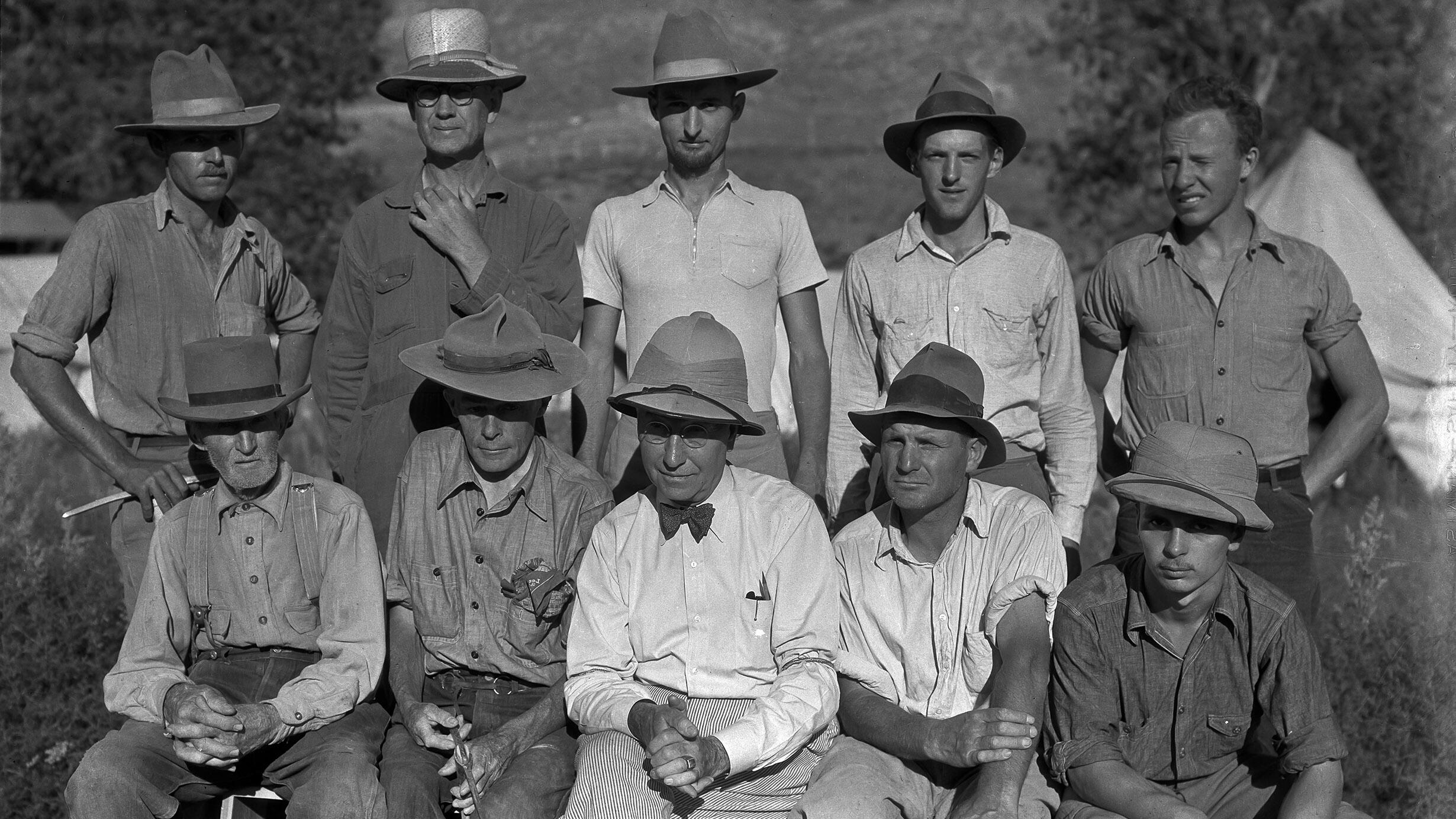 Howe Quarry expedition team members included Museum Barnum Brown (center, seated) and Roland T. Bird (far left, standing).
Howe Quarry expedition team members included Museum Barnum Brown (center, seated) and Roland T. Bird (far left, standing).©AMNH
In June 1935, Barnum Brown—the world-famous paleontologist who discovered Tyrannosaurus rex in 1902 and had collected thousands of fossils for the Museum starting in 1896—declared in Natural History magazine that he had made the fossil discovery of his lifetime.
Find out what Museum researchers are uncovering at other locations in the Morrison Formation, the fossil-rich region that includes Howe Quarry.
“Never have I uncovered a more interesting deposit of prehistoric remains, or seen one where the story of their death and entombment could be read with such clarity,” he wrote about the previous year’s expedition at Howe Quarry, located on a ranch just outside of Shell, Wyoming. There, the paleontologist known as Mr. Bones and his team had uncovered approximately 4,000 fossil bones in just six months, all from a small, densely packed area measuring 45 by 65 feet—a mass graveyard for ancient, mysterious animals.
©AMNH
The sheer scale of the find was staggering—and completely surprising. Brown had first heard of the Barker Howe Ranch and its dinosaurs from a local collector while scouting for fossils in the Big Horn Basin in Wyoming and Montana in 1932. Several large sauropod leg bones lay partially exposed on the property’s hillside. Having already uncovered other dinosaur skeletons in nearby locales—including Sauropelta and Tenontosaurus, which are now on view in the Museum’s Hall of Ornithischian Dinosaurs—Brown was determined to dig at the ranch.
Work began on June 1, 1934, and it didn’t take long for the team to realize that they had stumbled onto something exceptional. “Instead of two sauropod skeletons, there was a veritable herd of dinosaurs, their skeletal remains crossed, crisscrossed, locked, and interlocked in a confused and almost inextricable manner,” wrote Brown in his account for Natural History.
Want to know more about how Barnum Brown helped build the Museum’s remarkable fossil collection? Check out our video about his many discoveries.
He decided the best way to determine the relationships between individual dinosaurs was to study them on location. For two months, the team didn’t remove a single bone from the sand and mudstone bed. Instead, Brown accepted a suggestion from rookie expedition team member Roland T. Bird to create a quarry chart and draw a corresponding map, recording where each bone had been found. Now housed in the Museum’s Research Library, the map became integral to day-to-day operations and to deducing exactly how the mass grave came to be.
As Brown’s expedition team worked, they found more Jurassic-age sauropods and ornithischian dinosaurs; teeth belonging to several carnivorous dinosaurs, including some from Allosaurus; preserved sauropod skin tissues—the first ever found; sauropod stomach stones; and more. A prehistoric scene slowly came into focus: a group of sauropods, spooked by stalking predators, rushed into a watering hole that turned out to be a sticky, muddy death trap.
© AMNH
The Howe Quarry material was packed into about 140 cases and shipped in a box car back to the Museum. Weighing a total of 69,000 pounds, it was the second-largest single shipment from any expedition in Brown’s long and storied career. But while Brown had hoped to describe several new species of non-avian dinosaurs from the find himself, only a few specimens from the expedition were ever prepared or placed on view. (The neck and skull of a Kaatedocus siberi from Howe Quarry can be seen in the Sauropods at the Museum exhibit on the fourth floor, and fossil casts from the same specimen have been integrated into the juvenile sauropod on view in the Theodore Roosevelt Rotunda.)
A series of unfortunate circumstances, and World War II, prevented Brown from returning to Howe Quarry or from properly examining his finds. And so, the Howe Quarry collection remained tucked away in crates for decades—until last year.
Enter paleontologist Emanuel Tschopp, a Theodore Roosevelt postdoctoral fellow at the Museum’s Richard Gilder Graduate School, who’s picking up where Brown left off. “Howe Quarry is the reason I became a paleontologist,” he says.
“Howe Quarry is the reason I became a paleontologist.”
As a Ph.D.-degree candidate, Tschopp had discovered that a sauropod specimen collected at Howe Quarry by Switzerland’s Sauriermuseum Aathal (SMA) was a new species—Kaatedocus siberi. After conducting additional digs with SMA in the vicinity of the historic Howe Quarry site, Tschopp made his way to the Museum to work with the original Howe Quarry collection as a postdoctoral researcher with Mark Norell, Macaulay Curator in the Division of Paleontology.
With a team that includes Senior Museum Specialist Carl Mehling and Museum volunteers, Tschopp is diving into the collection to clean and prepare fossils, conduct CT scans of preserved braincases and chemical analysis of possible remains of soft tissues, and identify bones based on Bird’s original quarry map—a key document that provides researchers with context for reassessing the collection today.
Follow the progress of the Howe Quarry Project by joining the Museum’s Facebook group “Dino Detective.”
“We’re trying to figure out which species of these enormous animals were living together at the same place during the same time period, and how they managed to exist alongside each other,” says Tschopp.
A version of this story appeared in the Winter issue of the member magazine, Rotunda.